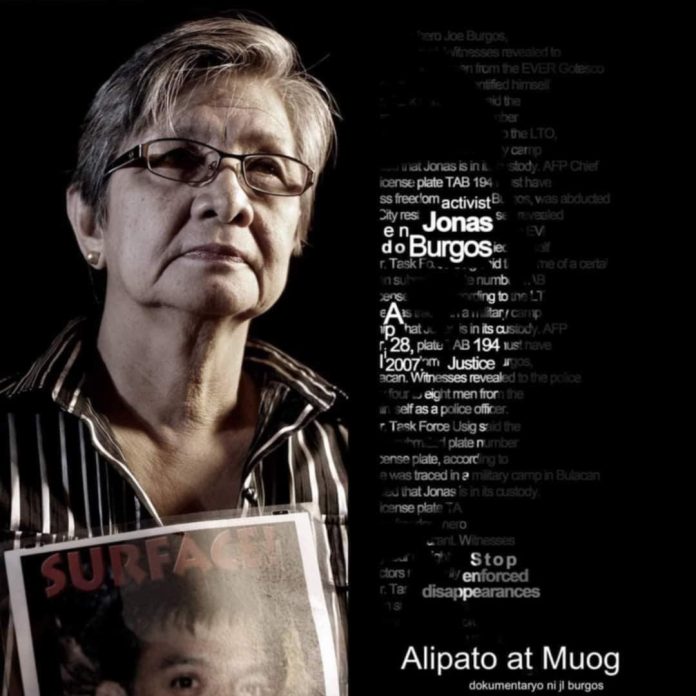Weeks before “Desaparecidos Day”, the documentary film “Alipato at Muog”( Flying Embers and a Fortress) by JL Burgos received the Special Jury Award during this year’s Cinemalaya Independent film festival.
“International Day of the Victims of Enforced Disappearances” or “Desaparecidos Day” is observed every August 30 annually since 2011 .
“Desaparecidos” is the Spanish and Portuguese word for “disappeared people” or victims of forced disappearance.
The film was given the award “for its effective use of the resources of documentary cinema to shed light on an actual case of enforced disappearance and reveal dark truths about human rights in the Philippines.”
The film seeks to “uncover the hard truths” surrounding the enforced disappearance of Jonas Burgos and other desaparecidos.
Peasant activist Jonas Burgos was abducted noontime of April 28, 2007 in a crowded mall in Quezon City. He was never seen again and the military has repeatedly denied any role in his disappearance.
As his family launched their search, a car plate brought them face to face with powerful forces.
Despite insurmountable barriers, anonymous informants have dropped leads and even provided the last known photo of Jonas in captivity. Edita, the 80-year old mother, and her filmmaker son lead the long and arduous fight for justice.
Presented through testimonials of their lawyer, a reporter, a former Justice Secretary and Human Rights Commission Chair, and witnesses who agreed to appear on condition of anonymity, combined with animation and never-before-seen footage of the family’s relentless search, the documentary film weaves the stories together to uncover the truths, however painful, about the brother’s disappearance.
“But how can justice prevail when the crime is committed by the very institution that is mandated to protect its people? Where does one even turn for answers? Telling Jonas’s story is telling the story of more than a thousand victims of enforced disappearance,” Jl Burgos said.
On February 2, 2014, the Supreme Court upheld the 2013 findings of the Court of Appeals which ruled that the military and the government are responsible for the disappearance of Burgos.
The United Nations (UN) Commission on Human Rights defined desaparecidos with three elements: (a) deprivation of liberty against the will of a person; (b) involvement of government officials, at least by acquiescence; and (c) refusal to acknowledge the deprivation of liberty or concealment of the fate or whereabouts of the disappeared person.
Data from the human rights group Karapatan and FIND indicated that there are between 950 to 1,000 desaparecidos during the late dictator’s term, 821 during Cory Aquino’s presidency, 39 under Ramos term, 26 under Estrada administration, 206 during Arroyo term, 29 during Noynoy Aquino’s administration, and 20 under Duterte term.
Burgos is one of the 206 desaparecidos under the Arroyo administration.
The truth about Burgos’ enforced disappearance remains to be a mystery. Meanwhile the suspects in the case, all military officers, have been promoted, granted choice positions in government and the military hierarchy and enjoy the perks that go with their positions.
“Our nightmare is the nightmare of every family of a desaparecido. There are no illusions that this documentary will stop enforced disappearances. But it is my hope that this film will serve as both a step towards finding Jonas and a stride towards justice for all victims of enforced disappearance.” JL Burgos said.
While most Filipinos fondly relive the memories of their dearly departed on All Saints Day and All Souls Day, families of desaparecidos have no closure nor graves to visit.
They have no graves on which to place lighted candles. Even after decades of looking for and not finding their loved ones, they cannot declare them finally and officially gone because there is no body.
The film Tumandok received five awards including Best Full Length Film, Felipe Ganancial as Best Supporting Actor, Best Screenplay, Best Original Music Score, and Network for the Promotion of Asia Pacific Cinema (NETPAC) full-length feature award. It featured the struggle of the Ati indigenous people to reclaim their ancestral domain in Iloilo.
Kono Basho won four awards: Gabby Padilla as Best Actress, Jaime Pacena II as Best Director, Best Cinematography, and Best Production Design.
Padilla shared the Best Actress award with Marian Rivera of Balota.
15-year old Enzo Osorio of “The Hearing” won as Best Actor “for his sensitive and very convincing portrayal of a boy who refuses to be silent and to be silenced about his abuse.”
Other winners in the Full Length category include: Sue Prado of Kantil as Best Supporting Actress; “An Errand” for Best Editing and Best Sound Design; and “Gulay Lang Manong” for Audience Choice.
The winners in the short film category are : “Cross My Heart and Hope to Die” for Best Film with Sam Manacsa as Best Director; “Primetime Mother” for Best Screenplay and Audience Choice; “Pamalandong Sa Danow” for Special Jury Award ” and “Abogbaybay” for the NETPAC Award.
(Peyups is the moniker of the University of the Philippines. Atty. Dennis R. Gorecho heads the Seafarers’ Division of the Sapalo Velez Bundang Bulilan Law Offices. For comments, e-mail info@sapalovelez.com, or call 09175025808 or 09088665786.)




